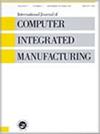Offline robot programming assisted by task demonstration: an AutomationML interoperable solution for glass adhesive application and welding
IF 3.7
3区 工程技术
Q2 COMPUTER SCIENCE, INTERDISCIPLINARY APPLICATIONS
International Journal of Computer Integrated Manufacturing
Pub Date : 2024-05-21
DOI:10.1080/0951192X.2024.2358042
引用次数: 0
Abstract
Robots have been successfully deployed in both traditional and novel manufacturing processes. However, they are still difficult to program by non-experts, which limits their accessibility to a wider range of potential users. Programming robots requires expertise in both robotics and the specific manufacturing process in which they are applied. Robot programs created offline often lack parameters that represent relevant manufacturing skills when executing a specific task. These skills encompass aspects like robot orientation and velocity. This paper introduces an intuitive robot programming system designed to capture manufacturing skills from task demonstrations performed by skilled workers. Demonstration data, including orientations and velocities of the working paths, are acquired using a magnetic tracking system fixed to the tools used by the worker. Positional data are extracted from CAD/CAM. Robot path poses are transformed into Cartesian space and validated in simulation, subsequently leading to the generation of robot programs. PathML, an AutomationML-based syntax, integrates robot and manufacturing data across the heterogeneous elements and stages of the manufacturing systems considered. Experiments conducted on the glass adhesive application and welding processes showcased the intuitive nature of the system, with path errors falling within the functional tolerance range.任务演示辅助离线机器人编程:用于玻璃粘合剂涂抹和焊接的 AutomationML 互操作解决方案
机器人已成功应用于传统和新型制造工艺中。然而,非专业人员仍然很难对它们进行编程,这就限制了更多潜在用户对它们的使用。机器人编程需要机器人技术和应用机器人的特定制造流程方面的专业知识。离线创建的机器人程序往往缺乏代表执行特定任务时相关制造技能的参数。这些技能包括机器人的方向和速度等方面。本文介绍了一种直观的机器人编程系统,旨在从熟练工人的任务演示中获取制造技能。演示数据(包括工作路径的方向和速度)通过固定在工人所用工具上的磁性跟踪系统获取。位置数据从 CAD/CAM 中提取。机器人路径姿势被转换到笛卡尔空间,并在模拟中进行验证,随后生成机器人程序。PathML 是一种基于 AutomationML 的语法,它在所考虑的制造系统的异构元素和阶段中集成了机器人和制造数据。在玻璃粘合剂应用和焊接过程中进行的实验展示了该系统的直观性,路径误差在功能公差范围内。
本文章由计算机程序翻译,如有差异,请以英文原文为准。
求助全文
约1分钟内获得全文
求助全文
来源期刊
CiteScore
9.00
自引率
9.80%
发文量
73
审稿时长
10 months
期刊介绍:
International Journal of Computer Integrated Manufacturing (IJCIM) reports new research in theory and applications of computer integrated manufacturing. The scope spans mechanical and manufacturing engineering, software and computer engineering as well as automation and control engineering with a particular focus on today’s data driven manufacturing. Terms such as industry 4.0, intelligent manufacturing, digital manufacturing and cyber-physical manufacturing systems are now used to identify the area of knowledge that IJCIM has supported and shaped in its history of more than 30 years.
IJCIM continues to grow and has become a key forum for academics and industrial researchers to exchange information and ideas. In response to this interest, IJCIM is now published monthly, enabling the editors to target topical special issues; topics as diverse as digital twins, transdisciplinary engineering, cloud manufacturing, deep learning for manufacturing, service-oriented architectures, dematerialized manufacturing systems, wireless manufacturing and digital enterprise technologies to name a few.

 求助内容:
求助内容: 应助结果提醒方式:
应助结果提醒方式:


